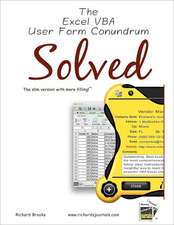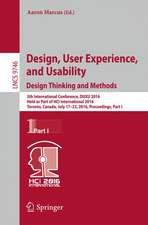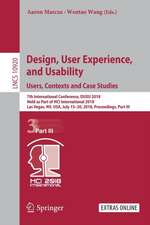User Research – Improve Product and Service Design and Enhance Your UX Research
Autor Stephanie Marshen Limba Engleză Paperback – 2 feb 2022
Many businesses are based on creating desirable experiences, products and services for users. However, companies often fail to consider the end user - the consumer - in their planning and development processes. How can marketing practitioners effectively understand their customers and create products and services that work for them? This book has the answers.
User experience research, also known as UX research, focuses on understanding user behaviours, needs and motivations through a range of observational techniques, task analysis and other methodologies. User Research is a practical guide that shows readers how to use the vast array of user research methods available. Written by one of the UK's leading UX research professionals, readers can benefit from in-depth knowledge that explores the fundamentals of user research.
Covering all the key research methods including face-to-face user testing, card sorting, surveys, A/B testing and many more, the book gives expert insight into the nuances, advantages and disadvantages of each, while also providing guidance on how to interpret, analyze and share the data once it has been obtained. Now in its second edition, User Research provides a new chapter on research operations and infrastructure as well as new material on combining user research methodologies.
| Toate formatele și edițiile | Preț | Express |
|---|---|---|
| Paperback (1) | 222.10 lei 3-5 săpt. | +21.58 lei 7-11 zile |
| Kogan Page – 2 feb 2022 | 222.10 lei 3-5 săpt. | +21.58 lei 7-11 zile |
| Hardback (1) | 702.91 lei 6-8 săpt. | |
| Kogan Page – 2 feb 2022 | 702.91 lei 6-8 săpt. |
Preț: 222.10 lei
Preț vechi: 277.62 lei
-20% Nou
42.50€ • 46.15$ • 35.70£
Carte disponibilă
Livrare economică 01-15 aprilie
Livrare express 18-22 martie pentru 31.57 lei
Specificații
ISBN-10: 1398603570
Pagini: 344
Dimensiuni: 156 x 233 x 20 mm
Greutate: 0.48 kg
Ediția:2. Auflage
Editura: Kogan Page
Cuprins
Chapter - 01: Introduction - Why is user research so important?; Section - ONE: The fundamentals - What good research looks like; Chapter - 02: Planning, objectives and legalities in user research; Chapter - 03: Best practice in user research - Who, what, why and how; Chapter - 04: Managing user research logistics - Agencies, facilities and contracts; Section - TWO: Selecting and using user research methods; Chapter - 05: Usability testing - Observing people doing things; Chapter - 06: Content testing - What do people think your content means?; Chapter - 07: Card sorting - Understanding how people group and relate things; Chapter - 08: Surveys - How to gauge a widespread user response; Chapter - 09: User interviews - Understanding people's experience through talking to them; Chapter - 10: Diary studies - How to capture user research data over time; Chapter - 11: Information architecture validation - Does the structure of your information work for your users?; Chapter - 12: Ethnography - Observing how people behave in the real world; Chapter - 13: Contextual inquiry - Interviewing people in their own environment; Chapter - 14: A/B Testing - A technique to compare different options; Chapter - 15: Getting the best out of stakeholder workshops; Chapter - 16: Guerrilla research - Running fast-paced research in the real world; Chapter - 17: How to combine user research methodologies; Section - THREE: Analyzing and presenting your data; Chapter - 18: Content analysis - A method of coding and making sense of your qualitative data; Chapter - 19: Affinity diagramming - Understand your data through identifying its themes; Chapter - 20: Prioritizing issues and user needs - What's important and what to work on next; Chapter - 21: Making recommendations - How to make your research findings actionable; Chapter - 22: Creating executive summaries and detailed reports to present results; Chapter - 23: Using video playback to present your research results; Chapter - 24: Using personas to communicate user characteristics and behaviours; Chapter - 25: Using mental models to visualize how users think and identify opportunities; Chapter - 26: Using journey and experience maps to visualize user research data; Chapter - 27: Using scenarios and storyboards to represent the user journey; Chapter - 28: Using infographics to translate numerical and statistical data; Chapter - 29: How to recommend changes to visual, interaction and information design; Chapter - 30: Conclusion




























